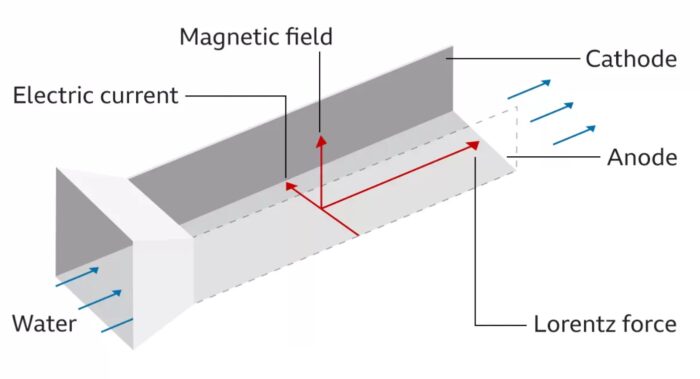 DARPA, the US Defense Advanced Research Projects Agency, is now working on developing a magnet-driven silent water propulsion system – the magnetohydrodynamic (MHD) drive. The primary reason is to develop silent military naval craft. Imagine a nuclear submarine with an MHD drive, without moving parts, that can slice through the water silently. No moving parts also means much less maintenance (a bonus I can attest to, owning a fully electric vehicle).
DARPA, the US Defense Advanced Research Projects Agency, is now working on developing a magnet-driven silent water propulsion system – the magnetohydrodynamic (MHD) drive. The primary reason is to develop silent military naval craft. Imagine a nuclear submarine with an MHD drive, without moving parts, that can slice through the water silently. No moving parts also means much less maintenance (a bonus I can attest to, owning a fully electric vehicle).
But don’t be distracted by the obvious military application – if DARPA research leads to a successful MHD drive there are implications beyond the military, and there are a lot of interesting elements to this story. Let’s start, however, with the technology itself. How does the MHD work?
The drive was first imagined in the 1960s. That’s generic technology lesson #1 – technology often has deeper roots than you imagine, because development often takes a lot longer than initial hype would suggest. In 1992 Japan built the Yamato-1, a prototype ship with an MHD drive that worked. It was an important proof of concept, but was not practical. Even over 30 years later, we are not there yet. The drive works through powerful magnetic fields, which are place at right angles to an electrical current, producing a Lorentz force. This is a force produced on a particle moving through both an electrical and magnetic field, at right angles to both. Salt water contains charged particles which would feel this Lorentz force. Therefore, if arranged properly, the magnetic and electrical fields could push water toward the back of the ship, providing propulsion.
Sounds pretty straight forward, so what’s the holdup? Well, there are several. The most important aspect of the Yamato-1 is that is provided great research into all the technical hurdles for this technology. The first is that the MHD drive is horribly energy inefficient, which means it was very expensive to operate. What was mainly needed to improve efficiency was more powerful and more efficient magnets. Here we get to generic technology lesson #2 – basic technology developed for one application may have other or even greater utility for other applications. In this case the MHD is partly benefiting from the fusion energy industry, which requires powerful efficient magnets. We can take those same magnet innovations and apply them to MHD drives, making them energy and cost effective.
But there is still one major and one minor problem remaining. The major problem is the electrodes and electronics necessary to generate the electrical current. Electronics and salt water don’t mix – the salt water is highly corrosive, more so when exposed to magnetic fields and electrical current. We therefore need to develop highly corrosive-resistant electrodes. Fortunately, such development is already underway in the battery industry, that also needs robust electrodes. Apparently we are not there yet when it comes to MHD, and that will be a major focus of DARPA research.
There is also the minor problem of the electrodes electrolyzing the salt water, creating bubbles of hydrogen and oxygen. This reduces the efficiency of the system – not a deal-killer, but it would be nice to reduce this effect. I immediately wondered if the created gases can be captured somehow, both solving the problem and making green hydrogen from the shipping industry. In any case, that’s problem #2 for DARPA to solve.
If all goes well, we are probably 10-20 years (or more) still away from working MHD drives on ships. Probably the military applications will come first. I hope they don’t hog the technology, which they might in order to maintain their military technological dominance, but the civilian applications can be huge. The noise generated by shipping has massive negative consequences on marine life, especially whales and other cetaceans who rely on long distance sound to communicate with each other, to navigate, and to migrate. Propellers churning up water is also an ecological problem. If it ever becomes cost effective enough, a working MHD drive could revolutionize ocean travel and shipping. Electrifying ocean propulsion could also help reduce GHG emissions.
Plus, there might be other downstream benefits from the DARPA research. Those robust corrosion resistant electrodes will likely have many applications. It may feed back into battery technology. It may also lead to better electrodes for a brain-machine interface. This reminds me of the book and TV series Connections, by James Burke. This is a brilliant series I have not seen in a while and should probably watch again. It traces long chains of technological developments, from one application to the next, showing how extensively technologies cross-fertilize. A need in one area leads to an advance that makes a completely different application feasible – and so on and so on. I guess that’s generic technology lesson #3.
DARPA has a solid history of accelerating specific technologies in order to bring new industries to fruition more quickly. Hopefully they will be successful here as well. The downstream benefits of an MHD drive could be significant, with spin-off benefits to many industries.
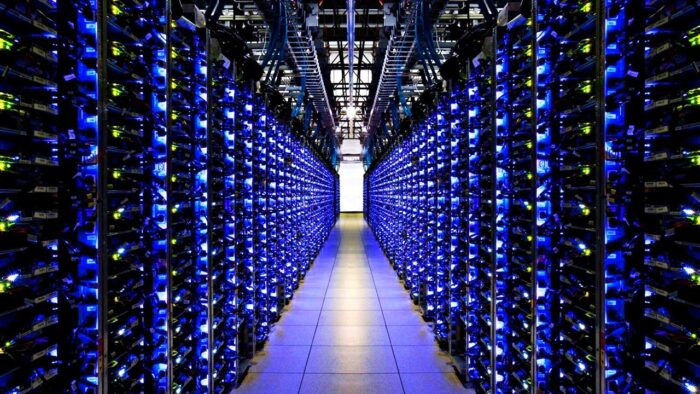 An analysis in 2021 found that 10% of the world’s electricity production is used by computers, including personal use, data centers, the internet and communication centers. The same analysis projected that this was likely to increase to 20% by 2025. This may have been an underestimate because it did not factor in the recent explosion of AI and large language models. Just training a large language model can cost $4-5 million and expend a lot of energy.
An analysis in 2021 found that 10% of the world’s electricity production is used by computers, including personal use, data centers, the internet and communication centers. The same analysis projected that this was likely to increase to 20% by 2025. This may have been an underestimate because it did not factor in the recent explosion of AI and large language models. Just training a large language model can cost $4-5 million and expend a lot of energy.
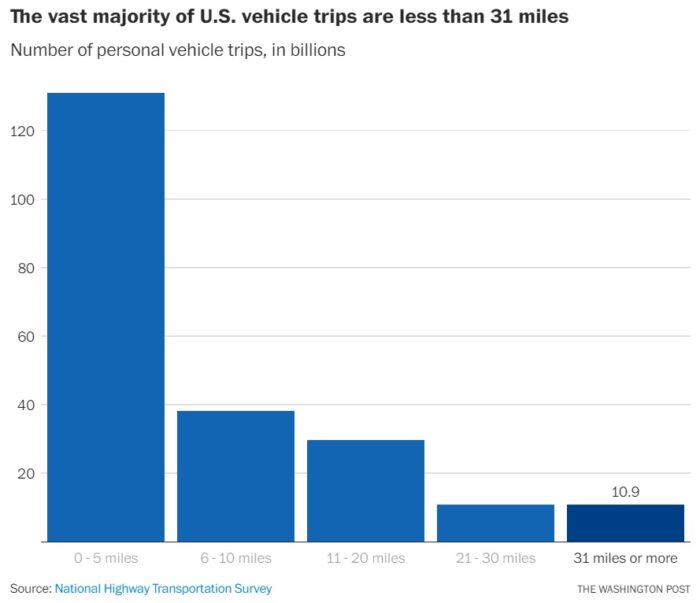 One of the key components of the plan to get our civilization to net zero by 2050 is to transform the motor vehicle fleet into all electric vehicles (EVs). This is a worthy goal, as it would eliminate burning gasoline for transportation. In fact it’s necessary if we want to get near net zero. Governments and the auto industry are responding with incentives for EVs, some regulations forcing the phasing out of internal combustion engine (ICE) vehicles, and investment of billions even trillions of dollars to change over production lines, secure raw material sources, and build charging stations.
One of the key components of the plan to get our civilization to net zero by 2050 is to transform the motor vehicle fleet into all electric vehicles (EVs). This is a worthy goal, as it would eliminate burning gasoline for transportation. In fact it’s necessary if we want to get near net zero. Governments and the auto industry are responding with incentives for EVs, some regulations forcing the phasing out of internal combustion engine (ICE) vehicles, and investment of billions even trillions of dollars to change over production lines, secure raw material sources, and build charging stations. Despite robust efforts to fight it, malaria remains one of the most significant infectious diseases affecting humans.
Despite robust efforts to fight it, malaria remains one of the most significant infectious diseases affecting humans.  DARPA, the US Defense Advanced Research Projects Agency,
DARPA, the US Defense Advanced Research Projects Agency,  It was six years ago
It was six years ago  One of the futuristic technologies that I find most promising is 3D printing (additive manufacturing). 3D printing has already created a revolution in manufacturing, but I think the general public does not have a high awareness of this technology because it is not yet at the point where it is ready to be a routine in-home appliance. It probably seems like an expensive toy. But in reality it is a key and rapidly growing prototyping and manufacturing technology. Importantly, there is tremendous potential for the technology to advance, and we are far away from a fully mature manifestation of 3D printing.
One of the futuristic technologies that I find most promising is 3D printing (additive manufacturing). 3D printing has already created a revolution in manufacturing, but I think the general public does not have a high awareness of this technology because it is not yet at the point where it is ready to be a routine in-home appliance. It probably seems like an expensive toy. But in reality it is a key and rapidly growing prototyping and manufacturing technology. Importantly, there is tremendous potential for the technology to advance, and we are far away from a fully mature manifestation of 3D printing.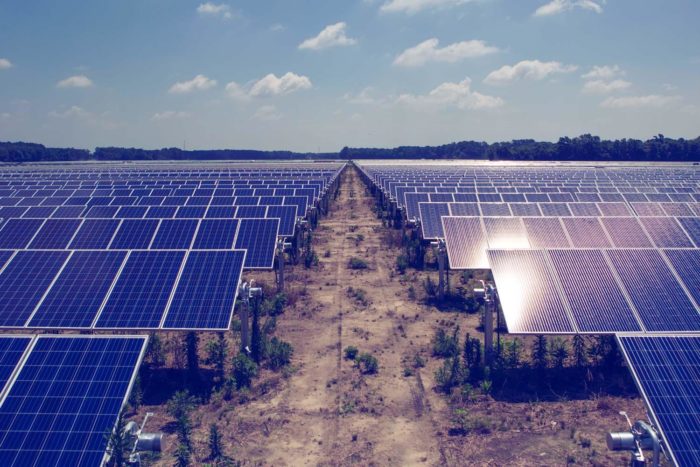 The climate change discussion would benefit most from good-faith evidence and science-based discussion. Unfortunately, humans tend to prefer emotion, ideology, motivated reasoning, and confirmation bias. As an example, I was sent an excerpt from a climate change podcast as a “rebuttal” to my position. The content, however, does not address my actual position, and I find many of the arguments highly problematic. This one is coming from a perspective that climate change is real and a definite problem that needs to be addressed, but seems to be advocating that the best solution is to be all-in on wind and solar without needing other solutions.
The climate change discussion would benefit most from good-faith evidence and science-based discussion. Unfortunately, humans tend to prefer emotion, ideology, motivated reasoning, and confirmation bias. As an example, I was sent an excerpt from a climate change podcast as a “rebuttal” to my position. The content, however, does not address my actual position, and I find many of the arguments highly problematic. This one is coming from a perspective that climate change is real and a definite problem that needs to be addressed, but seems to be advocating that the best solution is to be all-in on wind and solar without needing other solutions. I’ve been following AI (artificial intelligence) news very closely, including all the controversies and concerns. I tend to fall on the side of – AI is a powerful tool, we should continue to develop it and use it responsibly. We don’t need to panic, and highly restrictive laws are likely unnecessary and counterproductive. But there are legitimate concerns about the power of AI, especially in the “wrong” hands. I also think the greatest disruption to our lives might not come from cyberterrorists (although a legit concern) or AI run amok, but from marketing. Giving companies who see us only as customers the power to predict our every move gives me pause.
I’ve been following AI (artificial intelligence) news very closely, including all the controversies and concerns. I tend to fall on the side of – AI is a powerful tool, we should continue to develop it and use it responsibly. We don’t need to panic, and highly restrictive laws are likely unnecessary and counterproductive. But there are legitimate concerns about the power of AI, especially in the “wrong” hands. I also think the greatest disruption to our lives might not come from cyberterrorists (although a legit concern) or AI run amok, but from marketing. Giving companies who see us only as customers the power to predict our every move gives me pause. For the first time in over a decade, Apple has announced a new product designed to change computing. There was the transition to personal computing with the Apple computer, then to portable computing with the iPhone, and now they hope to usher in the transition to virtual computing with their Vision Pro. It may be emblematic of the response to their announcement that Apple stock prices dropped during the announcement.
For the first time in over a decade, Apple has announced a new product designed to change computing. There was the transition to personal computing with the Apple computer, then to portable computing with the iPhone, and now they hope to usher in the transition to virtual computing with their Vision Pro. It may be emblematic of the response to their announcement that Apple stock prices dropped during the announcement.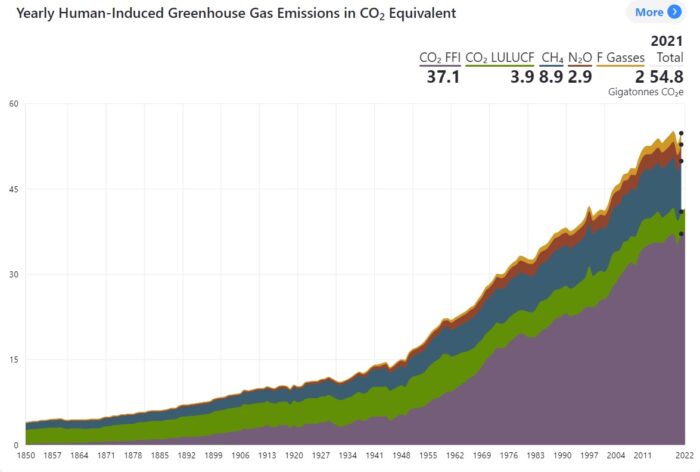 There
There 




